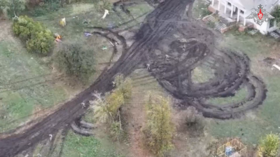Astronomers reveal 'surprising' massive cluster of 'ancient' stars at the heart of our galaxy
A group of international scientists has found a previously unknown "ancient stellar population" with rather unusual properties hiding in plain sight – right in the center of our galaxy.
This large group of stars likely originated as a globular cluster somewhere in the Milky Way and drifted to its middle long ago, they said. The discovery was detailed in two papers, published in the Astrophysical Journal Letters on Monday.
The astronomers said that they came across the star cluster as they were studying a massive black hole that lies at the core of our galaxy. It's surrounded by one of the densest fields of stars in the known universe, consisting of some 20 million celestial bodies.
However, this so-called 'Nuclear Star Cluster' (NSC) is pretty difficult to observe due to it being covered by dust clouds that block visible light. So, despite its dense star population, the area appears dark when looked upon from the outside.
Peeking through this darkness is only possible with equipment that captures much shorter or longer wavelengths, like the Very Large Telescope in Chile, which was used by the authors of the papers.
The scientists now believe that other galaxies also have a massive black hole in the middle and a nuclear star cluster around them, just like the Milky Way.
But with our galaxy, they're actually able to single out individual stars within the nuclear cluster due to the center of the Milky Way being around 25,000 light years away from Earth – a rather short distance, from an astronomical point of view.
The team analyzed some 700 stars in the area and say that they've found some of their properties to be "surprising." Some seven percent of those objects were characterized by relatively low "metallicity" or amounts of heavier elements, which indicate that they are older than others around them. They were also rotating faster and on a slightly different plane to the rest of the galaxy, compared to their counterparts.
Also on rt.com LISTEN: NASA shares symphony of the stars by turning telescope data into beautiful, haunting musicA computer simulation indicated that the newly-discovered cluster entered the Milky Way's central area within the past three to five billion years.
Think your friends would be interested? Share this story!














